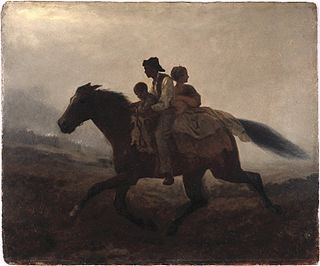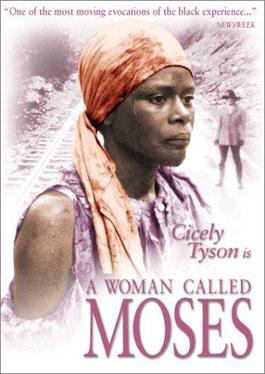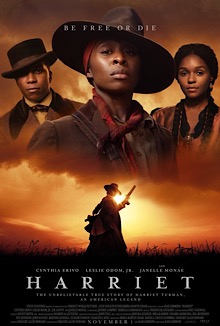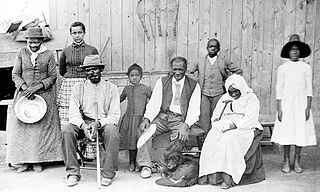Related Research Articles

The Underground Railroad was a network of secret routes and safe houses established in the United States during the early to mid-19th century. It was used by enslaved African Americans primarily to escape into free states and from there to Canada. The network, primarily the work of free African Americans, was assisted by abolitionists and others sympathetic to the cause of the escapees. The slaves who risked capture and those who aided them are also collectively referred to as the passengers and conductors of the Railroad, respectively. Various other routes led to Mexico, where slavery had been abolished, and to islands in the Caribbean that were not part of the slave trade. An earlier escape route running south toward Florida, then a Spanish possession, existed from the late 17th century until approximately 1790. However, the network generally known as the Underground Railroad began in the late 18th century. It ran north and grew steadily until the Emancipation Proclamation was signed by President Abraham Lincoln. One estimate suggests that, by 1850, approximately 100,000 slaves had escaped to freedom via the network.

Harriet Tubman was an American abolitionist and social activist. After escaping slavery, Tubman made some 13 missions to rescue approximately 70 enslaved people, including her family and friends, using the network of antislavery activists and safe houses known collectively as the Underground Railroad. During the American Civil War, she served as an armed scout and spy for the Union Army. In her later years, Tubman was an activist in the movement for women's suffrage.

William Still was an African-American abolitionist based in Philadelphia, Pennsylvania. He was a conductor of the Underground Railroad and was responsible for aiding and assisting at least 649 slaves to freedom towards North. Still was also a businessman, writer, historian and civil rights activist. Before the American Civil War, Still was chairman of the Vigilance Committee of the Pennsylvania Anti-Slavery Society, named the Vigilant Association of Philadelphia. He directly aided fugitive slaves and also kept records of the people served in order to help families reunite.

In the United States, fugitive slaves or runaway slaves were terms used in the 18th and 19th centuries to describe people who fled slavery. The term also refers to the federal Fugitive Slave Acts of 1793 and 1850. Such people are also called freedom seekers to avoid implying that the enslaved person had committed a crime and that the slaveholder was the injured party.

Thomas Garrett was an American abolitionist and leader in the Underground Railroad movement before the American Civil War. He helped more than 2,500 African Americans escape slavery.

The Cyrus Gates Farmstead is located in Maine, New York. Cyrus Gates was a cartographer and map maker for New York State, as well as an abolitionist. The great granddaughter of Cyrus-Louise Gates-Gunsalus has stated that from 1848 until the end of slavery in the United States in 1865, the Cyrus Gates Farmstead was a station or stop on the Underground Railroad. Its owners, Cyrus and Arabella Gates, were outspoken abolitionists as well as active and vital members of their community. Historian Shirley L. Woodward states that through those years escaped slaves came through the Gates' station.

The Raid on Combahee Ferry was a military operation during the American Civil War conducted on June 1 and June 2, 1863, by elements of the Union Army along the Combahee River in Beaufort and Colleton counties in the South Carolina Lowcountry.

John Hill Wheeler (1806–1882) was an American attorney, politician, historian, planter and slaveowner. He served as North Carolina State Treasurer (1843–1845), and as United States Minister to Nicaragua (1855–1856).

A Woman Called Moses is a 1978 American television miniseries based on the novel of the same name by Marcy Heidish, about the life of Harriet Tubman, the escaped African American slave who led dozens of other African Americans from enslavement in the Southern United States to freedom in the Northern states and Canada.

Harriet Tubman Underground Railroad State Park is a Maryland state park dedicated to the life and work of abolitionist and Underground Railroad activist Harriet Tubman. The park is on Route 335 near Church Creek in Dorchester County, adjacent to Blackwater National Wildlife Refuge.

The Harriet Tubman Memorial, also known as Swing Low, located in Manhattan in New York City, honors the life of abolitionist Harriet Tubman. The intersection at which it stands was previously a barren traffic island, and is now known as "Harriet Tubman Triangle". As part of its redevelopment, the traffic island was landscaped with plants native to New York and to Tubman's home state of Maryland, representing the land which she and her Underground Railroad passengers travelled across.

The Harriet Tubman Memorial, also known as Step on Board, is located in Harriet Tubman Park in the South End neighborhood of Boston, Massachusetts. It honours the life of abolitionist Harriet Tubman. It was the first memorial erected in Boston to a woman on city-owned property.

Harriet Tubman Day is an American holiday in honor of the anti-slavery activist Harriet Tubman, observed on March 10, and in the U.S. state of New York. Observances also occur locally around the U.S. state of Maryland. After Juneteenth became a federal holiday, there are growing calls for this day to also be observed at the federal level.

Harriet, the Woman Called Moses is an opera in two acts composed by Thea Musgrave who also wrote the libretto which is loosely based on episodes in the life of the American abolitionist and former slave Harriet Tubman. The opera premiered on 1 March 1985 in Norfolk, Virginia, performed by Virginia Opera with subsequent broadcasts of the Virginia Opera production on National Public Radio and BBC Radio 3. Musgrave also wrote two shortened versions of the opera—The Story of Harriet Tubman and the concert work Remembering Harriet.

The Harriet Tubman Underground Railroad Visitor Center is a visitors' center and history museum located on the grounds of the Harriet Tubman Underground Railroad State Park in Church Creek, Maryland, in the United States. The state park is surrounded by the Blackwater National Wildlife Refuge, whose north side is bordered by the Harriet Tubman Underground Railroad National Historical Park. Jointly created and managed by the National Park Service and Maryland Park Service, the visitor center opened on March 10, 2017.

Harriet is a 2019 American biographical film directed by Kasi Lemmons, who also wrote the screenplay with Gregory Allen Howard. It stars Cynthia Erivo as abolitionist Harriet Tubman, with Leslie Odom Jr., Joe Alwyn, and Janelle Monáe in supporting roles.

Harriet Tubman's birthplace is in Dorchester County, Maryland. Araminta Ross, the daughter of Benjamin (Ben) and Harriet (Rit) Greene Ross, was born into slavery in 1822 in her father's cabin. It was located on the farm of Anthony Thompson at Peter's Neck, at the end of Harrisville Road, which is now part of the Blackwater National Wildlife Refuge.

Harriet Tubman (1822–1913) was an American abolitionist and political activist. Tubman escaped slavery and rescued approximately 70 enslaved people, including members of her family and friends. Harriet Tubman's family includes her birth family; her two husbands, John Tubman and Nelson Davis; and her adopted daughter Gertie Davis.

The Tilly Escape occurred in October 1856 when an enslaved woman, Tilly, was led by Harriet Tubman from slavery in Baltimore to safety in Philadelphia. Historians who have studied Tubman consider it "one of her most complicated and clever escape attempts." It was a risky trip because Tubman and Tilly would not have been able to travel directly from Baltimore to Philadelphia without proof that they were free women. In addition, local slave traders would have recognized strangers. Tubman sought to evade capture by going south, before heading north, and using different modes of transportation over water and land.
The Dover Eight refers to a group of eight black people who escaped their slaveholders of the Bucktown, Maryland area around March 8, 1857. They were helped along the way by a number of people from the Underground Railroad, except for Thomas Otwell, who turned them in once they had made it north to Dover, Delaware. There, they were lured to the Dover jail with the intention of getting the $3,000 reward for the eight men. The Dover Eight escaped the jail and made it to Canada.